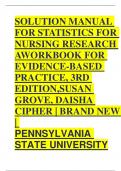SOLUTION MANUAL
FOR STATISTICS FOR
NURSING RESEARCH
AWORKBOOK FOR
EVIDENCE-BASED
PRACTICE, 3RD
EDITION,SUSAN
GROVE, DAISHA
CIPHER | BRAND NEW
|
PENNSYLVANIA
STATE UNIVERSITY
Statistics for Nursing
b b
,b Research Workbook for
b b
b Evidence-Based Practice
b
b 3rd Edition Susan Grove
b b b
b Daisha
,The questions are in bold followed by answers.
1. In Table 1, identify the level of measurement for the current therapy variable. Provide a
rationale for your answer.
Answer: The current therapy variable was measured at the nominal level. These drug categories
were probably developed to be exhaustive for this study and included the categories of drugs the
subjects were receiving. However, the categories are not exclusive, since patients are usually on
more than one category of these drugs to manage their health problems. The current therapies
are not measured at the ordinal level because they cannot be rank ordered, since no drug category
can be considered more or less beneficial than another drug category (see Figure 1-1; Grove &
Gray, 2019).
2. What is the mode for the current therapy variable in this study? Provide a rationale for
your answer.
Answer: The mode for current therapy was β blocker. A total of 100 (94%) of the cardiac patients
were receiving this category of drug, which was the most common prescribed drug for this
sample.
3. What statistics were conducted to describe the BMI of the cardiac patients in this sample?
Discuss whether these analysis techniques were appropriate or inappropriate.
Answer: BMI was described with a mean and standard deviation (SD). BMI measurement resulted
in ratio-level data with continuous values and an absolute zero (Stone & Frazier, 2017). Ratio-
level data should be analyzed with parametric statistics such as the mean and SD (Grove & Gray,
2017; Knapp, 2017).
4. Researchers used the following item to measure registered nurses’ (RNs) income in a study:
What category identifies your current income as an RN?
a. Less than $50,000
b. $50,000 to 59,999
c. $60,000 to 69,999
d. $70,000 to 80,000
e. $80,000 or greater
What level of measurement is this income variable? Does the income variable follow the
rules outlined in Figure 1-1? Provide a rationale for your answer.
Answer: In this example, the income variable is measured at the ordinal level. The income catego-
ries are exhaustive, ranging from less than $50,000 to greater than $80,000. The two open-ended
, AG 1-1




